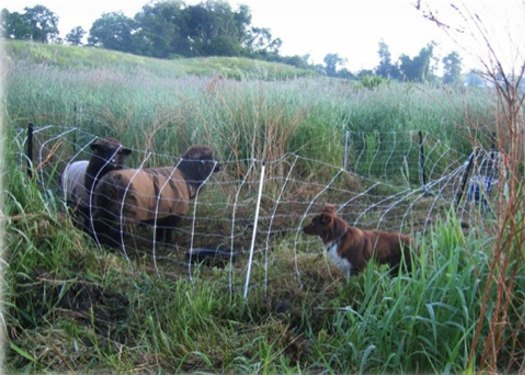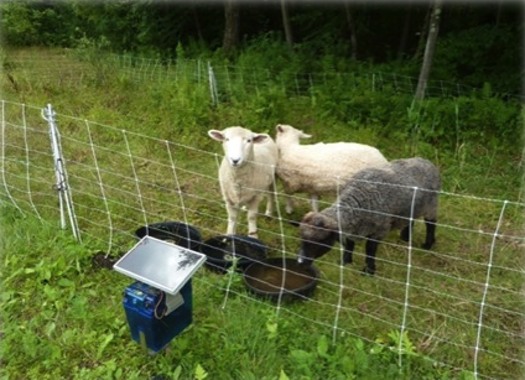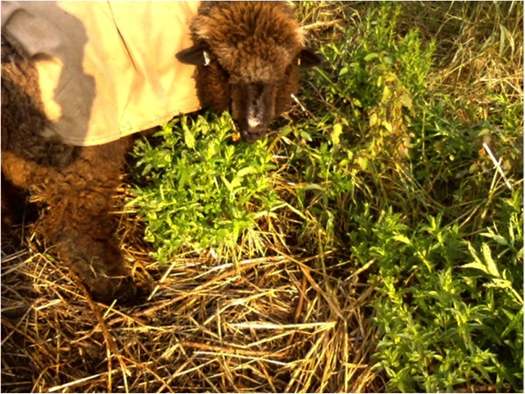Sheep eat the baaaaad

Sheep -- and dogs -- will be working to clear invasive plants from the Normanskill Farm.
There's a new (old) way to combat invasive plant species in upstate New York: small flocks of sheep.
Gary Kleppel, a professor of biological sciences at UAlbany and director of the Biodiversity Conservation and Policy Program there, is in the process of setting up a "targeted grazing" project using sheep at Albany's city-owned Normanskill Farm.
His sheep start arriving in a few weeks and then, with the help of students, dogs, and a fancy fence, the sheep get to work -- eating and gnawing at the plants that cause problems for our ecosystem.
So, why sheep -- and not pesticides, or just mowing the plants down? Says Kleppel:
Targeted grazing (TG) is already popular in many parts of the world (including the western US); TG will become increasingly popular in this region as the costs of fuel and herbicides (which are usually petro-chemicals) continue to climb. TG offers a tremendous alternative to more aggressive, "industrial" approaches (most of which rely heavily on fossil fuels) to managing invasive plants. The approach is "ecosystem-based", it can be used to restore landscapes rather than simply suppress invasives -- most managers find that appealing. And it fits well into integrated pest management and adaptive management strategies.
We asked him a few more questions about the project:
What are some of the invasive species you're hoping to combat with the sheep?
We'll be working on multiflora rose, purple loosestrife, Japanese knotweed and Phragmites australis this summer.
You'll be at the Normanskill Farm in Albany - what's there?
It is a former dairy, which is now operated by the City of Albany. School classes visit in May and June and our sheep will be used in demos.
Will you take me through the process of getting the sheep from one section of land to another?
1. About next week we'll begin bringing together our flock of culled sheep (mostly Romneys and Dorset crosses), getting them used to each other and to our border collies and making sure they are healthy.
2. At the same time we'll be setting up the barn, stocking up on hay, grain, minerals & medical supplies for the sheep.
3. We'll also divide the pasture (10-20 acres) into 1/4 acre paddocks (fenced off with moveable electric fencing) and wait until there is ample plant material in each paddock before we start the project

4. A typical day goes like this: Each morning, we drive (use the dog to move) the sheep from the barn to a paddock.
The sheep remain in the paddock for the day and then are returned to the barn for the night (this obviates predator problems). Next morning they are moved back out to the paddock. After 2-3 days, we switch to the next paddock.
During the entire period we are taking data to describe what is going on in the paddocks. We monitor the composition of the plant community and the growth of individual plants. We note which plant species are dominant and which species are, and are not, being eaten. We monitor the amount of grazing being done and the impact of the sheep on the soil (trampling). We monitor the microbial community, the seed bank and the transport of seeds in the sheep's feces. We make a complementary set of measurements in adjacent ungrazed portions of the landscape, for comparison.
5. We try to complete 2-4 cycles of all the paddocks each month or month and a half. We'll stay on-site (Normanskill Farm) until about the first frost. At that point we'll clean the barn (using the manure in the pastures), and return the sheep in the culled flock to their agricultural trajectory.
Do the sheep ever get full?
Grazing is eating. Like us, the sheep will graze for half an hour or so in the morning, rest for a half hour and then graze again; they will be most active after 4 pm, so we try to leave them out as late as possible in the summer. They select certain plants and ignore others; and they get full on some plants and switch to others.
The more we understand about this process the more we can control it to accomplish our management goals. As they eat, the sheep urinate and defecate, and that material helps to fertilize and improve the soil -- the effect of manure is different from that of artificial artificial fertilizer much as the effect of a grazer is different from that of a mower -- we are using a biological process to manage an ecosystem. Mowing, fertilizing, poisoning invasives is an industrial approach to management -- increasingly we're finding that the biological approach, though less efficient in the short term and not completely predictable (because it's complex), produces better results in the long term.

Why not goats?
We've used goats on some really difficult landscapes -- we may bring them in to deal with the advanced stages of multiflora rose in the current project. However, goats are difficult to fence and do not do well with dogs. They are also voracious feeders and must be managed very intensively if one's goal is to restore the landscape as well as to control invasives.
I've got some serious brambles in my backyard - can people rent out your sheep for home use?
You would probably want to rent the shepherd and dog as well -- otherwise I suspect you will have sheep in your flowerbeds and sheep in the road and possible sheep in the neighbor's pool. It's not difficult to manage a flock (and it's a lot safer than having a bunch of chemicals and poisons around the house), but it does require some expertise and probably the approval of your local planning board or [zoning board of appeals].
You did this with the state Department of Environmental Conservation before -- do you think you'll do more work with them in the future?
This is a DEC-sponsored project; we've also got a joint DEC-UAlbany proposal submitted to EPA for future funding; DEC hopes to replace some of its spraying program with targeted grazing. We are hoping to continue working with DEC to move New York State toward a reduced-herbicide, more biologically-based invasive plant management program. (It could be less costly and arguably as or more effective than the current approach)
You have a few papers published on this work - what do you think the future holds for your work on sheep and invasive plant management?
We know that the soil community, the plant community and grazers are intimately connected -- they depend on each other. We want to understand as much as we can about that coupling. We believe that with this understanding will come predictability --
the ability to forecast the outcomes of grazing in different landscapes. With that predictability comes the potential to manage landscapes more effectively for agriculture, wildlife conservation or human enjoyment.
This interview has been edited.
Earlier on AOA:
+ The Yellow Brick Road is near the Normanskill Farm
+ The Normanskill's Norman
+ Shopping with sheep
All photos courtesy Gary Kleppel.
Find It
Normanskill Farm
Mill Road
Albany, 12209
Hi there. Comments have been closed for this item. Still have something to say? Contact us.
Comments
The NYS Department of Environmental Conservation has a video up with footage of the sheep at the Saratoga Tree Nursery and an interview with Dr. Kleppel.
Video can be found at:
http://www.dec.ny.gov/dectv/dectv146.html
... said Bahhhhhh on Apr 27, 2011 at 11:51 AM | link
Everybody's getting into ethnic cuisine these days!
... said the_exile on Apr 27, 2011 at 2:37 PM | link
You can see a sheep herding demonstration at the Farm on Saturday, May 21 from 1 to 4 pm. Friends of the Norman's Kill Farm is holding an open house with tours of the farm, local artists, expert birder, blacksmiths at the rehabed forge & music.
... said danaphile on Apr 27, 2011 at 2:57 PM | link
Re: danaphile's comment
The blacksmith demos are fun!
http://alloveralbany.com/archive/2009/09/28/learn-to-be-a-blacksmith-no-really
... said jess on Apr 27, 2011 at 3:09 PM | link
The perfect animal for mankind. They eat your weeds. You make a sweater out of their outer fuzz. If they slow down you make a stew out of them.
And if you have trouble sleeping at night.....well start counting.
... said TD on Apr 27, 2011 at 5:41 PM | link